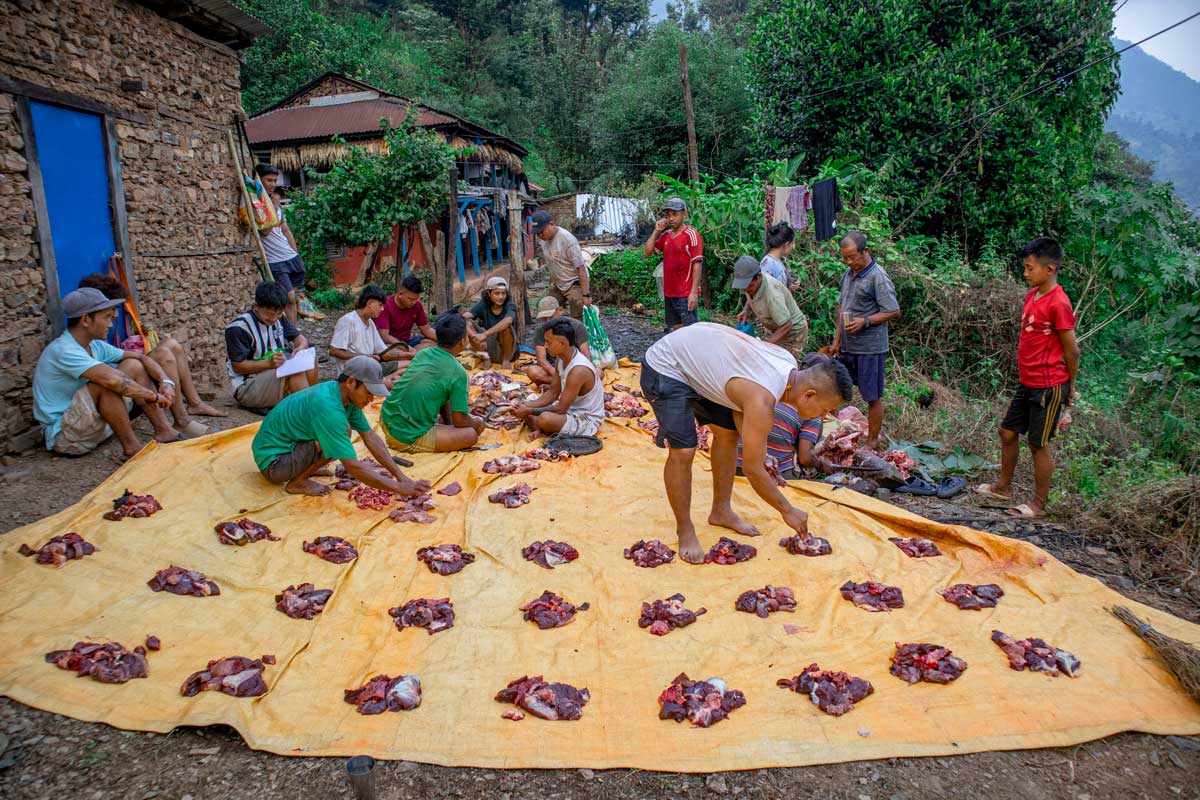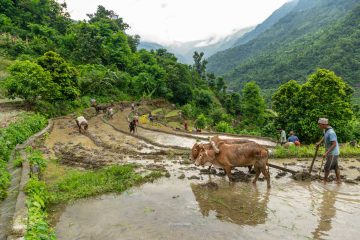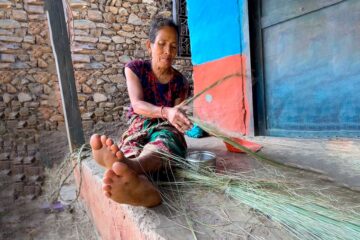In this traditional Nepali system, people don’t need to pay instantly instead they get months of time. So everyone could celebrate the festival, happily with the family and then work to earn and pay later. The system completely depended on Trust and Creditworthiness. And it is called “Moluwa or Bhaag”.
Introduced by Necessity
Just a couple of decades ago there was no proper means of transportation or easy access to markets. So people celebrated festivals or any auspicious occasion with whatever they could manage.
And since most people living in hilly regions didn’t have much cultivable lands, they highly depended on meat and dairy products from the animals they raised (like chicken, goats and buffaloes).
Meat was the most luxury product they could have for the celebration.
In Nepal, normally celebration means “Masu-Bhaat” (Rice, Lentil and Meat Curry).
But the problem with huge animals like Buffalo or goats was that one single family could not consume all of the meat, neither store for long days nor sell in the market, so they shared it with the whole village.
And another problem was not all people had the money at the time of butchering, so the village decided that anyone could have meat to celebrate the festival and they did not need to pay instantly. But they had to pay next month. It was a flexible system as the people got a month’s time to earn money and pay for the meat.
This way people could celebrate the festival with their family even if they didn’t have any money at the time.
Thus the traditional and ancient system of “Eat Now, Pay Later” called Moluwa or Bhaag System was started.
This system is still being used in rural villages like Khasrang in Nepal but with the ease of access to markets, it is on the verge of extinction like the Parma and Guhaar System.
How does the Moluwa or Bhaag System Works?
So, in this Moulwa or Bhaag system, a group of people take the full responsibility. And they are called “Jamani”.
Also, this Nepali word Jamani means “Guarantor” in English.
They go in search of an animal (usually Buffalo) for the meat and bargain with the owner. Once the price is negotiated, they give the date (which is usually in 1 or 2 months) to pay the money to the owner.
Then on the day of celebration or a day before, the animal is taken to the most feasible place for all the villagers and also easier to butcher and clean the meat before distribution.
As we discussed earlier, the system is performed during festivals when people need meat to celebrate with the family.
Once Jamani brings the animal to slaughter in specified place, other villagers also gather and help in the process

Since Buffalo is a huge animal it takes time to slaughter and then into smaller portions of meat, everyone helps in all the tasks. From cleaning the intestine to scraping meats from bones and marrow from the bone.
No part of the animal is wasted, everything is equally portioned for distribution.
Distribution System
Once all part of the meat is cut into equal distributable portions, it is then divided or apportioned according to the price of the animal.
For example if the price of the animal was negotiated at Rs 50,000, then the whole meat is divided into 50 equal portions with the price of Rs 1,000 each.
And if the village has 30 houses then each house can take 1 portion each and the rest can be shared among the ones who want to take more.
Sometimes during national festivals like Dashain and Tihar, most families want to take as much meat as possible. At this moment there may not be enough meat available. So it’s the responsibility of Jamani to distribute the meat in such a way that everyone is happy. On doing so, sometimes they even have to share their portion of meat.
And other times when there is no huge demand for meat, Jamani have to buy the excess meat which is not bought by other villagers.
Also while distributing the meat, Jamani takes the record of who took the meat in what quantity.
Later at the deadline, Jamani collects payment from everyone and gives the full payment to the animal owner.
So, the responsibility of Jamani is not for the profits, instead it’s for trust and credibility.
How is the Moluwa or Bhaag System Going to Extinct?
But unfortunately the system is becoming less and less used in the villages of Nepal, due to some of the following reasons
- Migration of People: With the people migrating to cities or abroad, there are not many people in villages to take the responsibility of Jamani and also with less people it’s difficult to find people who can consume all the meat within the village.
- People Leaving Agriculture as Occupation: Along with migration, another cause is people leaving Agriculture and Animal husbandry. These days people rather choose to go abroad as a labour or work in cities than stay in villages following the traditional occupation of Agriculture and Animal Husbandry. So it’s difficult even to find the animal to slaughter for meat.
- Easy Access of Market: Now with many people working abroad or in cities having money most of the time and at the same time access to the market is easy. So people now can buy meat from the market anytime they want and don’t need to wait for the festivals. Thus, they don’t depend on Jamani and prefer going to the market.
So, I feel like in another decade this system “Moluwa/Bhaag” will be a thing of the past.
Impact of Moluwa/Bhaag System in the Community
Moulwa or Bhaag system in Nepal reveals several key aspects of the past community:
- Strong sense of community and cooperation: The system thrives on collective participation and mutual assistance. Villagers actively contribute to the process, from helping with the slaughter and distribution to sharing the costs. This highlights a strong sense of community spirit and a willingness to work together for the common good.
- Emphasis on equitable distribution of resources: The system aims to ensure fair and equitable access to a valuable resource like meat, which was considered a luxury. By dividing the meat into equal portions and allowing for flexible distribution based on demand, the system minimizes disparities and ensures that everyone has the opportunity to participate in the celebration.
- Trust and creditworthiness: The “Eat Now, Pay Later” aspect of the system underscores the high level of trust and creditworthiness within the community. Villagers trust each other to fulfill their financial obligations, demonstrating strong social bonds and a shared sense of responsibility.
- Flexibility and adaptability: The system is flexible and adaptable to changing circumstances. It allows for variations in demand and adjusts the distribution accordingly. This flexibility ensures that the system remains relevant and sustainable within the evolving social and economic context of the community.
- Social safety net: The Moulwa system can be seen as a form of social safety net, enabling individuals to participate in important social events even if they lack the immediate financial means to do so. This system provides a valuable support mechanism for vulnerable members of the community.
Overall, the Moulwa or Bhaag system provides a fascinating glimpse into the social, economic, and cultural dynamics of past rural communities in Nepal. It highlights the importance of community cooperation, trust, and equitable resource distribution in fostering a just and equitable society.




